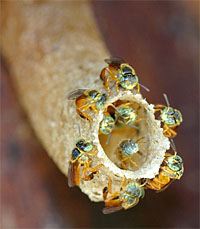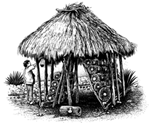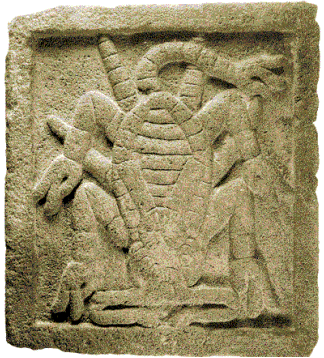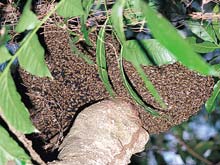at bottom I don't see the author's name.However I believe he is friends to a couple of friends of mine living in the Rio Dulce area of Guatemala.I am again surprised by the estimate of ovewr 30 species of stingless bee in Guatemala.After a couple of decades interest in stingless bees here I only known of two that are used as a source of honey in Guatemala and I only know them by the honey they produce rather than by their species classidfication.'Miel blanca' or 'white honey' is about the color of regular apis bee honey most people are familiar with around the world but slighlty more citric or lemony in taste and more liquidy probably due to a higher water content.The apis bee honey we are familiar with that pollinates our agricultural crops has about a 20% water content so the stingless bee only are over 20% water content.:
http://www.inriodulce.com/links/bees.html
Worldwide, bees have been sacred to the ancient civilizations. I recently had the opportunity to share what little I knew with a woman named "Maka" from Canada who was working on a documentary on bees and their rapid decline. I was honored and excited about the possibilities of what this may evolve as she has amazing information and I was able to learn much.
The Egyptians wrote about it back in 5500 B.C., the Indians used it for their religious ceremonies in 1000 B.C. and even the Babylonians have been noted to use it in their medicinal practices. The western world actually discovered the benefits of bee superfoods by accident during an investigation of native Russian Beekeepers who regularly lived past 100 years of age who ate raw honey, rich in bee pollen, every day.
Royal Jelly - Royal Jelly is a milk like secretion from the head glands of the worker bees. The queen bee lives almost exclusively on royal jelly and she lives around 40 times longer than the rest of the bees. Royal Jelly is a powerhouse of nutrients containing every nutrient necessary to support life. It is the worlds richest source of pantothenic acid (also known as Vitamin B5), which is known to combat stress, fatigue and insomnia and is a vital nutrient for healthy skin and hair.
Bee Pollen - Bee pollen is collected by bees from flowering plants and formed into granules. Bee pollen is the most complete food found in nature and has five to seven times more protein than beef. It is especially beneficial for the extra nutritional and energy needs of athletes and those recovering from illness. It is a natural antidote for fighting allergies particulary hayfever and sinusitus. Research shows that pollen counteracts the signs of aging and increases both mental and physical capability.
Propolis - Propolis is the substance that bees coat the walls of their hives with and bee hives have often been referred to as the most antiseptic places in nature. The powerful antibiotic properties of propolis can help protect humans from bacteria and can strengthen our immune system. Propolis works against viruses, something that antibiotics cannot do. Research shows that taking propolis during the high risk 'cold and flu' season reduces colds, coughing and inflammation of the mouth, tonsils and throat.
More recently I had the honor and pleasure of attending the international "VI Congresso de Abejas" here in Guatemala which is only held every three years. This was hosted by the University of San Carlos of Guatemala and the Centro de Estudios Conservacionistas. The guest speakers consisted of doctors, scientists, historians, professors in the departments of pharmacy, history, entomology and a vast range of others. I must admit to being overwhelmed with the quality and excellence of which this entire convention was conducted. My gratitude and respect to the ladies and all who presented this affair to the world. My sincerest thanks.
From what I learned at this convention, this section will be elaborated on extensively to share the importance and wonder of this creature. I should also mention that raw honey has been proven to aid in the healing of deep wounds, diabetic ulcers, open sores, gangrene, second and third degree burns where antibiotics have been far less effective. This is because germs cannot live in honey because of its antibiotic, antiviral, anti-inflamatory, anticarcinogenic, antifungal and other "anti" properties. But it has also been proven that the melipona far exceeds other honeys in its medicinal properties. From personal experience, I went to the congress with a broken leg and cast that had created sores that were severely infected. After trying a series of 1500mg of penecillin a day for two weeks with no visible improvement and then trying this honey and being completely healed after only four days, I am now a believer.
Here is some interesting trivia about bees that people should know. Bees' brains more powerful than computers (NaturalNews) A new study set to be published in the journal The American Naturalist has discovered that bees' tiny brains are capable of performing mathematical functions far more quickly and efficiently than even today's most powerful computers. According to the study, bees are able to quickly calculate the shortest flying routes among their network of flowers and plants in order to minimize flying time, a feat that even the speediest computers take days to solve.
The humble honey bee is getting its fair share of buzz this year — which doesn't bode particularly well for the species, or American agriculture as a whole. The most recent revelations involve leaked government documents, regulatory malfeasance, and scientific censorship. To mix an insect metaphor, it's quite a tangled web...
Since 2006, serious decimation of the North American bee population has taken place. Termed “colony collapse disorder,” millions of worker bees have mysteriously disappeared from their colonies, largely confounding the scientific community.Blame has volleyed from viruses to fungi to cell phone radiation...But a suspect has emerged as enemy number one: Bayer's pesticide clothianidin.Clothianidin is widely used on America's corn crops in addition to other ubiquitous crops like canola, soy, and sugar beets. For more information click here.
Although there are hundreds of types of bees here in the area I am going to focus here on the types that I feel stand out above the rest with the mention of the others. The Maya bees primarily the (Melipona beecheii), and the Orchid bees (Euglossini). Although all bees are worth mentioning if I had the time, these have unique characteristics that few other bees have the ability to do.
Only in Central America will you find the Orchid bee that pollinates the orchid flower, and the Maya bees have medicinal properties that still have scientists puzzled on what is in their diet to create it. Along with these two unique bee species, it would not be fair to omit information on the Africanized bee and its impact on the other bees of the area.
To learn more about the research going on with the Maya bees go here.

Orchid Bees
 During your travels in Central America you may come across some
brightly colored bees. They come in colors like green, blue, purple,
gold, and red. Some are even black with yellow or white hairs and
resemble bumble bees, which they are closely related but these are for
the most part Euglossini bees. Orchid bee is the common name for this
group of brightly colored bees found only here in the western hemisphere
from Mexico to Argentina. They are solitary bees that aren't very
social even though they may live in a colony.
During your travels in Central America you may come across some
brightly colored bees. They come in colors like green, blue, purple,
gold, and red. Some are even black with yellow or white hairs and
resemble bumble bees, which they are closely related but these are for
the most part Euglossini bees. Orchid bee is the common name for this
group of brightly colored bees found only here in the western hemisphere
from Mexico to Argentina. They are solitary bees that aren't very
social even though they may live in a colony. There
are more than 175 species of orchid bees but almost all of them collect
the pollen, nectar, and other substances from orchids with their
tongues that may be twice as long as their body. The long tongue allows
them to reach nectar in deep-throated tropical flowers that other bees
can not do. This is one reason that orchids raised commercially can only
be hand
pollinated for reproduction.
There
are more than 175 species of orchid bees but almost all of them collect
the pollen, nectar, and other substances from orchids with their
tongues that may be twice as long as their body. The long tongue allows
them to reach nectar in deep-throated tropical flowers that other bees
can not do. This is one reason that orchids raised commercially can only
be hand
pollinated for reproduction.Orchid bees are fast, strong fliers and can travel great distances in their quest for food. Some are know to fly as far as 28 to 31 miles (45 to 50 km) in their search. They get their energy from nectar they get along the way.
Male orchid bees are especially attracted to orchids, from which they collect fragrant oils that are stored in specialized receptacles on the hind legs. The orchids often produce no nectar or pollen, but they have special mechanisms that attach the pollinium, or pollen bundle, to a specific location on the bee as it gathers oils or searches for nectar. The pollinium releases its pollen on the next flower of the same species that the bee visits.
Males of some species are easy to observe because they can be attracted to artificial fragrances. Females are less attracted and thus less frequently seen. Orchid bees display very interesting foraging behaviors and are believed to be important pollinators of many tropical plants. Plants in the tropics do not grow in groups, and individual plants of the same species are often miles apart. Orchid bees are believed to forage on specific plants along set routes, a behavior known as traplining.
The nests of only a few orchid bee species have been found. Nests are constructed in cavities in wood, in fern roots, in the ground, in bamboo stems, in termite nests, under palm leaves, in crevices, under bridges on rocks, and on roofs of houses. Nests are lined with resin collected by the female. Some species seal up the nest entrance with resin at night. Some nests are constructed of wood chips or bark mixed with resin. Many species nest in groups. Some nests are shared by a number of individuals, but each female constructs her own brood cells (compartments for the young) independently. Nests may be used continuously by different generations of orchid bees. sa
Orchid bees in one genus have lost the ability to make their own nests. Instead, they parasitize the nests of other orchid bees. Other types of insects also parasitize the nests of orchid bees. These insects include velvet ants, blister beetles, and other types of parasitic bees.
Scientific classification: The orchid bees comprise the tribe Euglossini in the family Apidae, which includes honey bees and bumble bees. The largest orchid bee genus is Euglossa. Bumble bee-like species belong to the genus Eulaema. Parasitic orchid bees are in the genus Exaraete.
You won't get stung by the next group of bees, but while we are on the topic of bees, it is probably a good time to talk about stings.

Mayan Bees
 The next group of bees I will show you about are the Maya bees (Meliponinae). The bee on the left is the prized (Melipona beecheii)
([Xunan kab] which means
'royal lady' in Mayan) which were used for the strength of their
medicinal properties. There are 33 species of melipona left here in
Guatemala but their numbers are declining rapidly. They are tropical,
eusocial, stingless honeybees
, they are among the smallest of all bees. Although their stings are
reduced and do
not function, many species are by no means defenseless. Attack consists
of biting and of crawling into the eyes, ears, nose, and hair of
animals that disturb them.
The next group of bees I will show you about are the Maya bees (Meliponinae). The bee on the left is the prized (Melipona beecheii)
([Xunan kab] which means
'royal lady' in Mayan) which were used for the strength of their
medicinal properties. There are 33 species of melipona left here in
Guatemala but their numbers are declining rapidly. They are tropical,
eusocial, stingless honeybees
, they are among the smallest of all bees. Although their stings are
reduced and do
not function, many species are by no means defenseless. Attack consists
of biting and of crawling into the eyes, ears, nose, and hair of
animals that disturb them.
 Nests are constructed of cerumen, a mixture
of resin and wax, with mud sometimes added. The brood cells, unlike those
of true honeybees, open upward and are arranged in horizontal combs
or in clusters. Click on this image and you will see the comb in the center with
the round honey storage containers to the right. Stingless-bee colonies vary from a few hundred up
to the largest colonies of all bees, with more than 100,000 individuals. Each
colony contains a queen that becomes swollen with eggs and unable
to fly. Young queens, rather than old queens as in true honeybees,
leave to establish new colonies. No parasitic stingless bees exist;
a few species, however, live by robbing.
Nests are constructed of cerumen, a mixture
of resin and wax, with mud sometimes added. The brood cells, unlike those
of true honeybees, open upward and are arranged in horizontal combs
or in clusters. Click on this image and you will see the comb in the center with
the round honey storage containers to the right. Stingless-bee colonies vary from a few hundred up
to the largest colonies of all bees, with more than 100,000 individuals. Each
colony contains a queen that becomes swollen with eggs and unable
to fly. Young queens, rather than old queens as in true honeybees,
leave to establish new colonies. No parasitic stingless bees exist;
a few species, however, live by robbing. According to Maya history, Maya bees—native to the tropical
forests of Mexico's Yucatán peninsula—symbolize a link to the
spirit world, a bequest of the god Ah Muzen Cab. Another reference to the Maya bee can be found in a story of the origin of
the town Quiche', the first men of this town were fed by their creator, Rabinal Achí, with white honey (Odoriferous clay
1995). In the Popol Vuh we found that the first four men who were created took to their women honeycombs to eat (Popol Vuh
1965). Can be seen that the honeycombs and the honey, that cannot be of that of the bees without sting, paracen to represent
a very good food source, with which sustained the first men.
According to Maya history, Maya bees—native to the tropical
forests of Mexico's Yucatán peninsula—symbolize a link to the
spirit world, a bequest of the god Ah Muzen Cab. Another reference to the Maya bee can be found in a story of the origin of
the town Quiche', the first men of this town were fed by their creator, Rabinal Achí, with white honey (Odoriferous clay
1995). In the Popol Vuh we found that the first four men who were created took to their women honeycombs to eat (Popol Vuh
1965). Can be seen that the honeycombs and the honey, that cannot be of that of the bees without sting, paracen to represent
a very good food source, with which sustained the first men.
The Maya bee, is native to south-eastern Mexico, northern Central America to South America. This bee has long been cultivated by the Maya peoples. The bee and its culture are dying out due to deforestation, pesticides, and the labor intensity of its honey production. This bee is in some danger of becoming extinct.
 The Maya cultural practice of bee husbandry dates back thousands of
years. Even today you will see hollowed logs either hanging or stacked
on racks as in the picture on the left to house the hives. In the
ancient Maya culture, honey was used as a
sweetener, antibiotic, and as an ingredient in the Maya version of mead
called "Balche". Balche was made from fermented honey and the bark of
the leguminous Balché tree (Lonchocarpus violaceus), hence its name. It
was traditionally brewed in a canoe. The drink was known to have
entheogenic properties, that is, to produce mystical experiences, and
was consumed in medicinal and ritual practices. The hallucinogenic
properties come from tan alkaloid in the bark of the Balché tree,
although whether the hallucinogens came from the bark or the honey,
which beekeepers would harvest after placing the nests near the trees,
remains uncertain. Toxic and hallucinogenic substances can be found in
all honey, if bees collect nectar and pollen from certain types of
vegetation. Most likely, it is a combination of the two, since balché is
made from both the Melipona honey gathered from the Balché flowers, and
from the bark of the tree, brewed and fermented together.
The Maya cultural practice of bee husbandry dates back thousands of
years. Even today you will see hollowed logs either hanging or stacked
on racks as in the picture on the left to house the hives. In the
ancient Maya culture, honey was used as a
sweetener, antibiotic, and as an ingredient in the Maya version of mead
called "Balche". Balche was made from fermented honey and the bark of
the leguminous Balché tree (Lonchocarpus violaceus), hence its name. It
was traditionally brewed in a canoe. The drink was known to have
entheogenic properties, that is, to produce mystical experiences, and
was consumed in medicinal and ritual practices. The hallucinogenic
properties come from tan alkaloid in the bark of the Balché tree,
although whether the hallucinogens came from the bark or the honey,
which beekeepers would harvest after placing the nests near the trees,
remains uncertain. Toxic and hallucinogenic substances can be found in
all honey, if bees collect nectar and pollen from certain types of
vegetation. Most likely, it is a combination of the two, since balché is
made from both the Melipona honey gathered from the Balché flowers, and
from the bark of the tree, brewed and fermented together.
 The
bee God "Ah Mucen Kab" was celebrated. Honey was used by their shamen,
the H-men, in elaborate rituals. If they accidentally killed a bee, they
reverently wrapped it in a leaf and buried it. From the Melipona honey,
they created a fermented drink known as balche, still relished in the
region. Beeswax was used in candles and lostwax casting of metal
objects. These fascinating practices were detailed in what must have
once been thousands of colorful illustrated bark fiber books created by
the Maya.
The
bee God "Ah Mucen Kab" was celebrated. Honey was used by their shamen,
the H-men, in elaborate rituals. If they accidentally killed a bee, they
reverently wrapped it in a leaf and buried it. From the Melipona honey,
they created a fermented drink known as balche, still relished in the
region. Beeswax was used in candles and lostwax casting of metal
objects. These fascinating practices were detailed in what must have
once been thousands of colorful illustrated bark fiber books created by
the Maya.
 Of the 500 or so species of sting less bees in the tropical world, the favorite species among Maya beekeepers has been
Melipona beecheii. Its traditional name, xunan kab (or kolil kab in the Mayan language), means "royal lady."
Of the 500 or so species of sting less bees in the tropical world, the favorite species among Maya beekeepers has been
Melipona beecheii. Its traditional name, xunan kab (or kolil kab in the Mayan language), means "royal lady."
In the Maya tradition, a priest harvested sting less bee honey as part of a religious ceremony twice a year. To increase the number of hives and honey production, beekeepers would regularly divide existing nests.
Today the honey is still used medicinally by the locals as an eye medicine by putting some honey in an irritated eye before sleep at night and the reaction flushes impurities and infection from that area.
Maya bees harvest pollen from the few indigenous plants and trees that are also endangered in the tropics which they now have to compete for with the Africanized bee.

Africanized Bees
(Apis melifera)
 I am pretty sure that you have heard of the aggressive nature of the africanized bee. Without a doubt, that part is true
as I can attest from personal experience while out with a beekeeper working on his hives. The Africanized honeybee is a
hybrid of European and African bees. Hybridization resulted when African bees brought to Brazil
half a century ago interbred naturally with European bees previously introduced to the area. Since then Africanized
honeybees have spread over South and Central America and into the United States.
I am pretty sure that you have heard of the aggressive nature of the africanized bee. Without a doubt, that part is true
as I can attest from personal experience while out with a beekeeper working on his hives. The Africanized honeybee is a
hybrid of European and African bees. Hybridization resulted when African bees brought to Brazil
half a century ago interbred naturally with European bees previously introduced to the area. Since then Africanized
honeybees have spread over South and Central America and into the United States. It is not only the aggressive nature of the Africanized bee that is causing endangerment to other species of bees. It is also in part that they are good honey producers and the quantity of honey that they provide make them more popular to beekeepers of the Yucatán peninsula for propagation than the Mayan bees. While a colony of sting less bees may produce a few pounds of honey per year, Africanized honeybees can produce 220 pounds (100 kilograms). The biggest threat to the extinction of bees is narrowing down, not to Africanized bees, or loss of habitat which are major contributers; but man and his use of pesticides on crops for commercial use.
